The MLMA declares that it is the policy of the state of California to conserve the health and diversity of marine ecosystems and resources, and to encourage the sustainable use of those resources (§7050(b)(opens in new tab)). This chapter is focused on the specific objectives regarding the sustainability of fish stocks and the tools and approaches for achieving sustainability across different scales of management. As noted in Chapter 1, the MLMA defines sustainability to mean both the continuous replacement of marine resources, taking into account fluctuations in abundance and environmental variability, and securing the fullest possible range of present and long-term economic, ecological, and social benefits. To achieve this goal, the MLMA states the following:
- Each FMP shall specify criteria for identifying when a fishery is overfished (§7086(a)(opens in new tab)).
- A depressed fishery is defined as a fishery with a declining population trend occurring over a period appropriate to that fishery, or a fishery with abundance levels below those consistent with MSY (§90.7(opens in new tab)). A fishery may be depressed due to non-fishing related impacts.
- Overfished(opens in new tab) is defined as a depressed fishery where reduction of take in the fishery is the principal means for rebuilding the population (§97.5(opens in new tab)).
- Overfishing(opens in new tab) is defined as a rate or level of taking that the best available scientific information, and other relevant information that the Commission or Department possesses or receives, indicates is not sustainable or jeopardizes the capacity of a marine fishery to produce the MSY on a continuing basis (§98(opens in new tab)).
- If a fishery is overfished or where overfishing is occurring, the FMP shall contain measures to prevent, end, or otherwise address overfishing, and to rebuild the fishery (§7086(b)(opens in new tab)).
- If a fishery is overfished, FMPs or regulations shall specify a time period for addressing overfishing and rebuilding(opens in new tab) the fishery. The time period should be as short as possible and shall not exceed 10 years except in cases where the biology of the population of fish or other environmental conditions dictate otherwise. Overfishing restrictions and recovery benefits must be allocated fairly and equitably among sectors of the fishery (§7086(c)(2)(opens in new tab)).
- Every sport and commercial marine fishery shall be managed so that the long-term health of the resource is not sacrificed for short-term benefits. In the case of a fishery managed on the basis of MSY, management shall have OY as its objective (§7056(a)(opens in new tab)).
- Status reports to the Commission are required to identify any fishery that does not meet the sustainability policies of the MLMA. In the case of a fishery identified as depressed, the reports should indicate the causes of the depressed condition of the fishery, describe the steps being taken to rebuild the fishery, and, to the extent practicable, recommend additional steps to rebuild the fishery (§7066(b)(opens in new tab)).
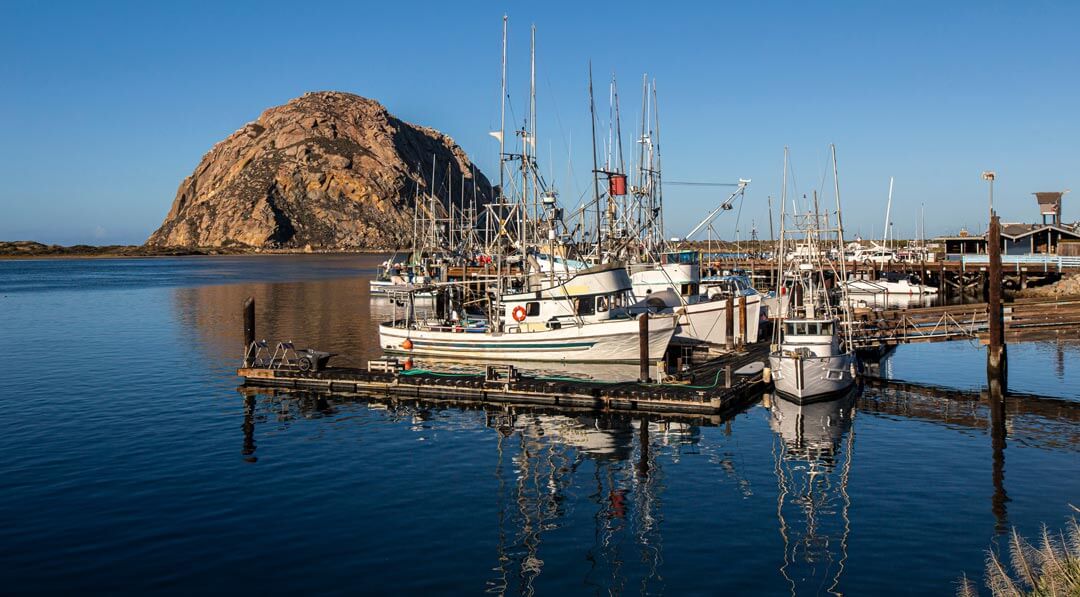 Fishing fleet in Morro Bay. (Favious/Shutterstock photo)
Fishing fleet in Morro Bay. (Favious/Shutterstock photo)
Achieving sustainability
The sustainable management of fisheries requires information on the status of a population relative to management targets. This has generally involved developing estimates of abundance and the number of individuals that can be removed without harming the population or ecosystem. To develop these estimates, fisheries scientists have devised increasingly complex statistical models(opens in new tab) that have become a recognized tool in fisheries management. These models typically require long time-series of catch, effort, biological, and survey data. Many California fisheries lack this type of information or have unique biological or ecological characteristics that violate the assumptions of traditional stock assessment models. Such fisheries are often referred to as data-limited or data-poor(opens in new tab). However, a lack of data should not prevent the adoption of management measures. In recent years, alternative approaches have been developed that require less data, rely on basic fishery statistics rather than models, and adjust exploitation rates based on the level of uncertainty. At the federal level, scientists have developed new techniques for setting Annual Catch Limits (ACL)(opens in new tab) for hundreds of previously unassessed stocks and found that it is possible to develop good management policies using limited data. These new approaches create opportunities to advance the MLMA’s sustainability goals in California’s fisheries as well.
This chapter provides considerations and guidance for traditional and more data-limited approaches to fisheries management at each stage of the fisheries management cycle. It also provides recommendations for making management decisions more consistent and structured through the use of MSE.
The fishery management cycle
The fishery management cycle is composed of the following components (Figure 4, clockwise from top left): 1) data collection on population status, life history(opens in new tab) parameters, and fishing trends and impacts; 2) data analysis to understand stock status; 3) Harvest Control Rules (HCRs)(opens in new tab); and 4) implementation of management measures as regulations. An orchestrated approach to this cycle represents an ideal scenario that may not be necessary or feasible for some California fisheries with very low economic value or participation. Nevertheless, each component contains strategies that should be considered when managing fisheries. These components are summarized below, and guidance and considerations are identified for each. A more detailed discussion of each stage of the cycle is provided in Appendices H-K.
 Figure 4. Components of the fishery management cycle.
Figure 4. Components of the fishery management cycle.
Data collection
A key component of the adaptive management mandated by the MLMA is a process to use the data collected to understand how the system is responding to management. This monitoring process allows managers to learn more about the system generally and provides inputs for the determination of stock status and the subsequent decision-making process. Fisheries management decisions are traditionally based on knowledge of the biomass(opens in new tab) of the stock. This understanding is typically provided by population models that use high-quality data analyzed by staff with quantitative modeling skills.
ESRs and FMPs should identify EFI for the fishery. EFI is defined as any information related to the biology of a fish species or fishing activities that is necessary to manage the fishery in accordance with the requirements of the MLMA (§93(opens in new tab)). It includes information on the species’ life history, habitat requirements, stock status in terms of abundance and size or age structure, fishing effort, catch levels, and fishery impacts on other marine living resources. The data used to monitor and manage fisheries come from two primary sources: fishery-dependent(opens in new tab) and fishery-independent(opens in new tab) monitoring programs.
Appendix H provides details on types of EFI, data collection strategies to support decision-making in both data-rich(opens in new tab) and data-limited fisheries, and an overview of the Department’s current data collection efforts.
Key higher-level considerations in identifying data collection strategies include:
- While the Department is the primary agency responsible for collecting EFI, it shall encourage the participation of fishery participants to the maximum extent practicable (§7060(a-c)(opens in new tab)).
- Fishery-dependent data, which are collected directly from fishing activities, have lower sampling costs, but may be influenced by how and where the fishery operates, unreliable, inadequate, or missing. These problems may be accounted for if management and market changes influencing fishing behavior are carefully documented.
- Fishery-independent data are collected from surveys designed and conducted by Department staff, fishermen, other scientists, and trained volunteers. These data are less biased but costlier to collect.
- In fisheries that lack any data other than landings or catch information, data on abundance, distribution, and basic biology are often the easiest to collect, and can provide initial information regarding stock status.
- Long-established MPAs may represent an opportunity for assessing data-poor fisheries by acting as a reference area, allowing for the comparison of fished and unfished conditions. As monitoring increases understanding of MPA effects on fishery yields, the Department will need to determine an approach to quantitatively assess these impacts.
- Historical information may be available from non-traditional sources such as processors(opens in new tab)/buyers or from stakeholders or researchers with a long history of involvement in the fishery.
- The transition to electronic data collection programs presents key opportunities to standardize and streamline data collection, involve fishermen and processors, and ensure that the data being collected helps to inform management and identify and adapt to climate-related changes.
- The FMP development process also represents an opportunity to ensure that data are collected as part of a research protocol that is designed to support decision-making.
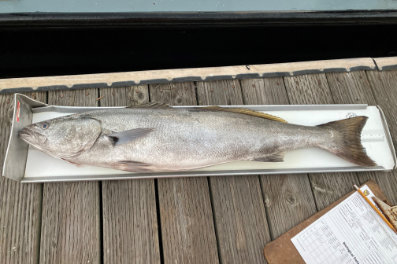 Measuring a white seabass. (CDFW photo by Kristine Lesyna)
Measuring a white seabass. (CDFW photo by Kristine Lesyna)
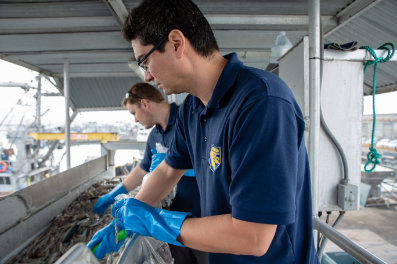 Squid sampling. (CDFW photo by Trung Nguyen)
Squid sampling. (CDFW photo by Trung Nguyen)
Stock assessments
Stock assessment is a generic term for any type of data analysis that can provide an estimate of the status of a fish stock. These analyses can provide one or more indicators of the stock’s present and projected abundance given varying conditions including environmental change and fishing pressure. Most commonly this indicator is an estimate of the size of the fish stock (abundance), but it may also be an estimate of the fishing mortality rate or stock resilience. Stock assessment tools range from very simple estimators that rely on a single data stream to complex models that require many kinds of data and simultaneously analyze those diverse data to find the best overall fit. These complex population models are often referred to as integrated assessments.
Stock assessments can be valuable to the fishery management process. They provide estimates of past and present stock abundance, and of difficult-to-measure processes such as spawner-recruit relationships and annual
recruitment(opens in new tab), which can help managers to understand stock productivity and resilience. Long-term data on the relative abundance of the target species within a network of well-established MPAs may be useful in stock assessments (
Wertz et al. 2011 (PDF)(opens in new tab)). Assessments may also provide a platform for forecasting how the stock is likely to fare under alternative management measures such as changes in season length or size requirements. Finally, these types of assessment models allow managers to calculate reference points(opens in new tab), which are quantitative benchmarks that capture the management objectives for the fisheries (either desired targets, or limits to be avoided).
Assessments rely on several assumptions, which frequently introduce uncertainty into the process, and their results must be interpreted with an understanding of the nature and degree of uncertainty. In the federal management process, the consideration of uncertainty and evaluation of assumptions and results occurs during a rigorous, multi-day process for stock assessment review before the results are used for management.
Data-limited assessment techniques
There are many reasons why traditional assessment methods may be inappropriate or infeasible for specific fisheries. Small fisheries are often data-limited, and while they may represent important fisheries for their users, their relatively low economic value may make it difficult to justify the allocation of limited resources for monitoring. Fisheries may be in developmental phases, only fished opportunistically given sporadic stock availability, or recovering from collapse or closure. Many nearshore fisheries exhibit high spatial variation within a relatively small area, and this may violate the assumption of uniformity across the stock area required by many traditional assessment methods. For all these reasons, there has been increasing interest in developing assessment methods that use available information in a less complex modeling environment than for integrated assessments. The choice of the right assessment approach is governed by the types of data available as well as other factors, including life history characteristics and management capacity. Data-limited methods have the potential to help advance the MLMA’s goals in many of California’s data-limited fisheries. Appendix I includes a list and description of data-limited assessment techniques and provides considerations associated with their use. A summary of those considerations is provided below.
Key considerations in selecting assessment strategies:
- Traditional stock assessments often rely on time series of fishery-dependent and fishery-independent data. While they are a recognized tool for fisheries management, they may not be possible to conduct for fisheries with limited data, or because of the considerable expertise, time, and effort needed to conduct such assessments.
- Data-limited assessments are generally easier and faster to conduct than integrated assessments and offer potential for improving management for many of California’s fisheries.
- Catch-based methods use historical catch data to attempt to set sustainable catch limits(opens in new tab). They are most appropriate for management systems that accurately monitor catch and can enforce fishery closures once catch limits are met.
- Some length-based methods use length composition data to estimate key biological processes and the productivity of the stock using a single year of data.
- MPA-based assessment methods compare data collected from inside an MPA in which fishing for the target stock is prohibited to data collected from adjacent fishing grounds outside the MPA. These methods are most reliable when the target species is known to receive significant protection from fishing within the state’s network of MPAs, and when the MPAs have been in place for 10+ years, are large relative to the home range of the fish, and are well enforced.
- Empirical indicators do not use an assessment method to calculate stock status. Instead, catch or fishing effort is adjusted up or down depending on where the indicator (such as Catch Per Unit Effort (CPUE)(opens in new tab)) falls compared to a target.
The appropriate assessment and supporting data collection strategy will depend on the goals and acceptable risks. MSE (discussed below) should be used in both data-rich and data-limited fisheries to evaluate which assessment methods are most appropriate given the fishery’s characteristics.
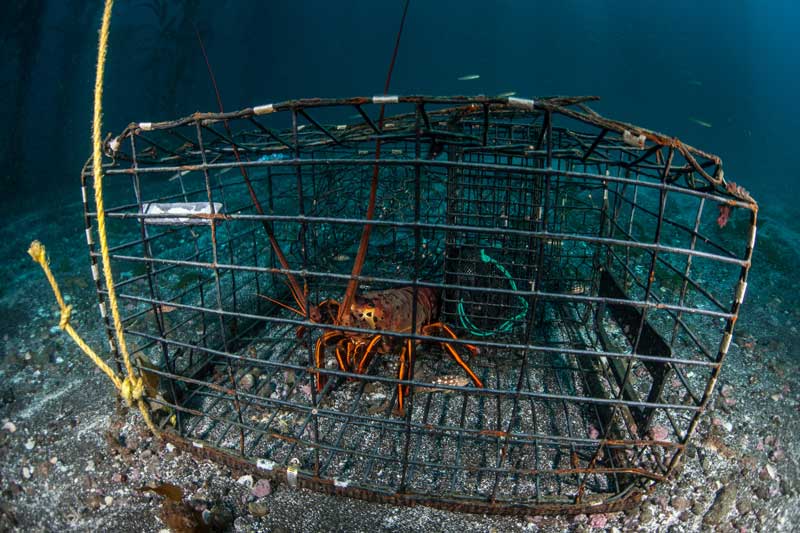 Spiny lobster in a trap. (Ethan Daniels/Shutterstock photo)
Spiny lobster in a trap. (Ethan Daniels/Shutterstock photo)
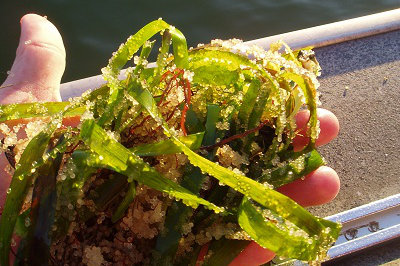 Pacific herring eggs on eelgrass. (CDFW photo by Ryan Bartling)
Pacific herring eggs on eelgrass. (CDFW photo by Ryan Bartling)
Harvest Control Rules and reference points
A key component of many effective harvest strategies is an HCR, which is simply a set of pre-determined and agreed upon rules used for determining a management action in response to changes in indicators of stock status with respect to reference points. In the absence of an HCR and once a stock assessment is conducted, decision makers and stakeholders most often negotiate which management changes are most appropriate. This negotiation process can lead to slow management response times and high levels of controversy between user groups with differing objectives. HCRs improve this process by creating pre-determined decision-making frameworks that reflect management objectives as well as the best available science.
Typically, HCRs compare results from the stock assessment phase (also known as indicators) against reference points. Reference points are metrics that combine several components of fishery performance into a single index. Management actions may be required depending on where the indicator falls relative to the reference point. Reference points are commonly expressed as either a biomass level or fishing mortality rate that would achieve that biomass level under long-term equilibrium fishing conditions. They do not have to take the form of MSY-based biomass thresholds and can also be set with various proxies and triggers, such as declines in CPUE or landings. FMPs are required to contain measures to prevent, end, or otherwise address overfishing, and to rebuild the fishery (§7086(b)(opens in new tab)). Reference points are essential tools for identifying overfishing and rebuilding overfished stocks.
HCRs explicitly link the outcomes of monitoring and assessment with the management response. This is important because while stock assessments often return estimates of parameters such as fishing mortality and abundance, these parameters cannot be directly controlled by managers. Instead, regulations are established to modify fishing behavior in a way that is expected to result in the desired effect on these parameters. Well-established MPAs may be useful in HCR development and implementation. For example, McGilliard et al. (2011) evaluated the potential use of the ratio of the density of fish outside an MPA to that inside the MPA each year (the density ratio) in a control rule to determine the direction and magnitude of change in allowable fishing effort in the next year. HCRs should be developed in the management planning stage with the involvement of stakeholders. One way to involve stakeholders in the process is to seek their input on the management objectives and performance metrics by which to evaluate possible HCRs.
HCRs should be evaluated to ensure they perform reasonably well under a range of uncertainties in stock status, environmental conditions, harvester behavior, and the ability to implement effective regulations. In systems with more uncertainty, the HCR should be more precautionary. Additionally, as discussed in Chapter 11, climate change will underscore the need for adaptive management and responsive HCRs. Appendix J provides details on the types of HCRs available, use of ecosystem indicators, and considerations for how effective use of HCRs can advance the goals of the MLMA.
Key considerations in selecting HCR strategies include:
- The MLMA requires FMPs to include criteria for determining when a fishery is overfished (§7086(a)(opens in new tab)). Reference points that are quantitative benchmarks defining zones of fishery performance (e.g., healthy, subject to overfishing, and critical/overfished zones) can provide a mechanism for defining these criteria. Different management actions are required based on where a fishery indicator falls relative to these reference points.
- HCRs can range in complexity based on the data availability and needs of the fishery. Examples include triggering a management action when a reference point is passed, a “traffic light” system where multiple indicators are monitored simultaneously, a decision tree where reference points are sequentially assessed, or a mathematical formula linking stock status to the following year’s catch or effort level.
- When insufficient information is available to set reference points, proxies for key biological reference points can be used. Often, these proxies are easier to calculate and require less data.
Management measures to regulate fishing activities
Fisheries managers have a suite of possible regulatory mechanisms, known as controls or management measures, available to them. These mechanisms include restrictions on catch, effort, gear, season, size of fish, number of participants, and areas fished. Fishery controls are usually classified as either output controls(opens in new tab) or input controls(opens in new tab) (Morrison 2004). If the control measure directly constrains the catch, it is an output control, and if it constrains fishing effort (by restricting who can fish when, where, and how) it is an input control. An appropriate choice will depend on a variety of factors, including the biology of the species, how the fishery is prosecuted, socioeconomic issues, community objectives, and governance capacity. Input and output controls are not mutually exclusive; some fisheries employ both.
Key considerations in selecting management measures include:
- Input controls are an indirect way to control the number of fish caught by limiting who, when, where, and how fish are captured. They include restrictions on gear type or amount, season, fishery participation, vessel number and size, geographic area, and time spent fishing.
- Output controls are direct limits on the amounts and kinds of fish that can be caught. These include Total Allowable Catches (TACs)(opens in new tab) and limits on size, sex, or species.
- Fisheries management is usually composed of a suite of input and output controls because each control type has different advantages and disadvantages. Each requires different kinds of monitoring and enforcement, and each has different socioeconomic and biological implications.
- As discussed in Chapter 11 and Appendix K, management can enhance fish stocks’ resilience by using measures that maintain and strengthen the reproductive capacity by ensuring a diverse age structure.
- When a fishery is identified as overfished, reduction in the take of the fishery is the principal means for rebuilding the population (§97.5(opens in new tab)).
- The role of MPAs in helping a fishery to meet management goals should be considered (see Appendix D).
- Working closely with the affected stakeholder community is essential to crafting effective management measures.
Specifics regarding available management measures and the considerations associated with their use are provided in Appendix K.
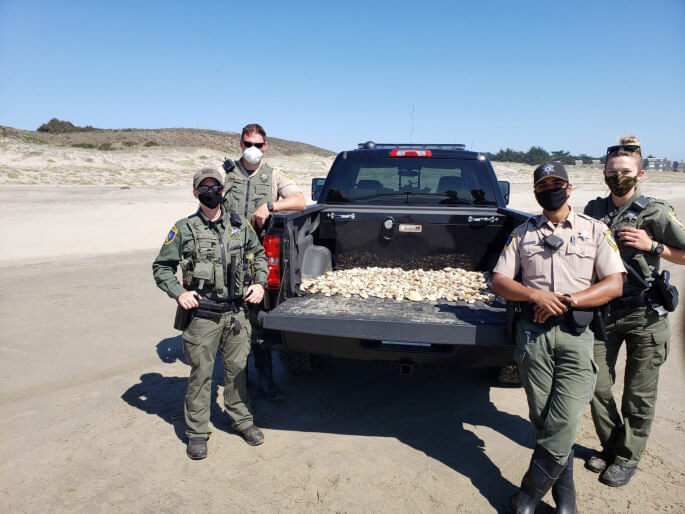 Wardens enforcing management measures seized a pickup load of Pismo clams from poachers. Many of the clams measured approximately half the legal size. (CDFW photo)
Wardens enforcing management measures seized a pickup load of Pismo clams from poachers. Many of the clams measured approximately half the legal size. (CDFW photo)
Management Strategy Evaluation
The fishery management cycle (Figure 4) functions best when each of the components is chosen with the other components in mind. MSE is the generic term used for a class of analyses that test potential combinations of these management procedures and explicitly address the tradeoffs and levels of uncertainty associated with them. In MSE, the entire fishery management cycle is simulated over a specified time period (i.e., 50 years) to understand how each aspect of the management procedure is likely to perform in both the short- and long-term. The procedure uses many repeated simulations with randomly drawn variables to explore the risk of unwanted outcomes due to uncertainty stemming from natural variation, climate change, lack of knowledge, and imperfect implementation of management measures. MSE allows the identification of what is known and what is unknown, and examination of tradeoffs among alternative management strategies. This examination can include a risk analysis that compares the probability of achieving the desired management result for each potential management strategy.
While MSE is useful for evaluating potential management strategies based upon risk tolerance, it can be complex, and requires extensive time and resources to conduct. In the past, significant quantitative expertise was required to build and run simulation models. Recent advances have made MSE faster, more affordable, and more accessible to a wider range of fisheries, including those with limited data. However, even with these technological advances the behavior of the fishery must be modeled as accurately as possible, and that usually requires gathering information from stakeholders, biologists, and managers who know the fishery best. As such, MSE represents an excellent opportunity to partner with stakeholders, academics, and other outside experts to accurately and comprehensively characterize the fishery and its management goals, determine which performance metrics are most informative, interpret results, and evaluate tradeoffs. Appendix L provides guidance on each step of the MSE process.
Available tools
Fisheries scientists have recently recognized that MSE can be used to compare a wider range of management procedures and can be applied to a number of data-limited scenarios with relatively simple data indicators and iterative HCRs (Carruthers et al. 2014). From this premise, fishery modelers at the University of British Columbia developed the Data-Limited Methods Toolkit(opens in new tab) (DLMtool). The DLMtool can evaluate a wide variety of potential management approaches and allows users to develop customized management procedures to include in the MSE analysis. The tool can also help managers and stakeholders evaluate methods for stock assessment. For certain high-value, high-volume, or high-risk fisheries, significant investment in management, such as that required to produce an integrated stock assessment, may be warranted, but many stocks can be effectively managed using less data-intensive methods or baseline monitoring. The DLMtool can provide an efficient analytical technique for designing and implementing these types of management procedures. The Department partnered with academic institutions and Non-Government Organizations (NGOs) to pilot the tool on a small group of state-managed fisheries (see: Applying Management Strategy Evaluation to California Fisheries: Case Studies and Recommendations (PDF)(opens in new tab)).
The DLMtool is one of many similar tools that have been developed. In selecting among available tools, a key criterion should be that it is a peer-reviewed and proven approach for the kind of fishery to which it is applied. Application of these tools and their underlying approaches will be a major step towards extending more active and strategic management to a greater proportion of the state’s fisheries and achieving the sustainability goals of the MLMA. They will be applied to priority fisheries wherever resources and capacity permit.
Photo at top of page: Kelp bass (foreground) swimming with a school of California sheephead. (Greg Amptman/Shutterstock photo)